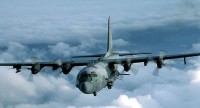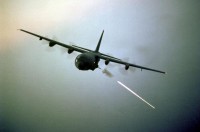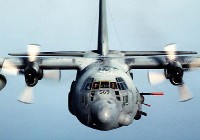|
Global Aircraft -- AC-130 Spectre
Aviation Center
US Attack
US Bombers
US Cargo
US Fighters
US Helicopters
US Patrol/Pursuit
US Reconnaissance
US Tankers
US Trainers
US UAV's
US X Planes
Orbiter Vehicles
WWI Aircraft
WWII Aircraft
Airbus
Antonov
Boeing
Dassault
Ilyushin
Kamov
MiG
Mil
Saab
Sukhoi
Tupolev
Yakovlev
Joint/Rest of World
Entertainment Center
Members Center
New Technologies
Contact Us
Extra Navigation
GAC Engine
AC-130 Spectre Specifications
AC-130 Spectre Achievements
AC-130 Spectre Features
These heavily armed aircraft incorporate side-firing weapons integrated with sophisticated sensor, navigation and fire control systems to provide surgical firepower or area saturation during extended loiter periods, at night and in adverse weather. The sensor suite consists of a television sensor, infrared sensor and radar. These sensors allow the gunship to visually or electronically identify friendly ground forces and targets any place, any time. The AC-130U employs synthetic apertures strike radar for long-range target detection and identification. The gunship's navigational devices include the inertial navigation systems and global positioning system. The AC-130U employs the latest technologies and can attack two targets simultaneously. It also has twice the munitions capacity of the AC-130H. Source: http://www.af.mil
AC-130 Spectre Background
The AC-130H's call sign is "Spectre." The AC-130U's call sign is "Spooky. " The U-model is the third generation of C-130 gunships. All gunships evolutionized from the first operational gunship, the AC-47. The AC-130 gunship has a combat history dating to Vietnam. Gunships destroyed more than 10,000 trucks and were credited with many life-saving close air support missions. During Operation Urgent Fury in Grenada in 1983, AC-130s suppressed enemy air defense systems and attacked ground forces enabling the successful assault of the Point Salines Airfield via airdrop and air land of friendly forces. The AC-130 aircrew earned the Lt. Gen. William H. Tunner Award for the mission. AC-130s also had a primary role during Operation Just Cause in Panama in 1989 when they destroyed Panamanian Defense Force Headquarters and numerous command and control facilities. Aircrews earned the Mackay Trophy for the most meritorious flight of the year and the Tunner Award for their efforts. During Operation Desert Storm, AC-130s provided close air support and force protection (air base defense) for ground forces. Gunships were also used during operations Continue Hope and United Shield in Somalia, providing close air support for United Nations ground forces. Gunships also played a pivotal role in supporting the NATO mission in Bosnia-Herzegovina. The AC-130H provided air interdiction against key targets in the Sarajevo area. In 1997, gunships were diverted from Italy to provide combat air support for U.S. and allied ground troops during the evacuation of American noncombatants in Albania. Gunships also were part of the buildup of U.S. forces in 1998 to convince Iraq to comply with U.N. weapons inspections. More recently, both aircraft have been employed in support of Operation Enduring Freedom. Gunships provided armed reconnaissance, interdiction and direct support of ground troops engaged with enemy forces. Source: http://www.af.mil | ||||||||||||||||||||||||||||||||||||||||||||||




